 This is great when your site has a shed. Before you build a shed it is necessary to determine the place of work. Keep in mind that your shed will be standing here for decades maybe, so everything has to be well thought, the place should be comfortable for you. This small building should organically fit into the overall landscape of your site and be in harmony with other buildings. Some people prefer to hide their sheds in the back area of their sites, others build sheds right next to their house.
This is great when your site has a shed. Before you build a shed it is necessary to determine the place of work. Keep in mind that your shed will be standing here for decades maybe, so everything has to be well thought, the place should be comfortable for you. This small building should organically fit into the overall landscape of your site and be in harmony with other buildings. Some people prefer to hide their sheds in the back area of their sites, others build sheds right next to their house.
The most suitable types of soil for laying a shed foundation are rocky, sandy, gravel, sandy loam and loam. The most desired one is the first. The rocky ground does not freeze. However, it is a bit hard to dig. The worst one is sandy loam or loam soil. It freezes deep so you have to dig too deep.
You may wonder how deep a groove under a foundation should be. Since a shed refers to light buildings it needs a small-flush foundation. The depth of a foundation under a shed depends on the type of soil and the depth of its freezing in winter, but the average depth is usually 2 feet.
Before you start it is necessary to prepare a solution consisting of cement, sand, gravel and water.
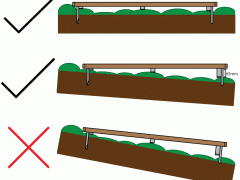 Please, don’t forget about the following rules:
Please, don’t forget about the following rules:
- buying cement check the date of its manufacture and choose the recently made one;
- for greater efficiency of cement it is better to buy gravel of different diameters, both large and small – small grains will serve as an interlayer between the larger stones;
- rubble shouldn’t contain debris and contaminants;
- water must be clean, even better than drinking one;
- sand should not be mingled with clay or silt.
Mix sand with gravel in the ratio 3:5, add cement and pour all the water to make a thick homogeneous mass.
A strip foundation
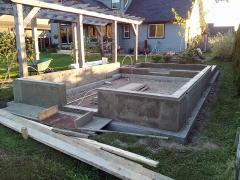 The most popular type of shed foundations. For making it you need to dig a trench on the whole perimeter of your future shed. The depth of the trench must be equal to the depth at which the soil is frozen in winter, plus extra 0,5 foot. Its width should be of about 2,4 feet. The width of a foundation base is equal to about 1,3 feet. Then make the formwork the height of which should be about 1 foot above ground level – it will protect your foundation from getting wet. Then make a valve grid serving to strengthen your foundation. The width of the grid cells –are about 1 foot. Next, fill your future foundation with concrete and after curing you can remove the wooden frame and seal the intervals with ground (if needed).
The most popular type of shed foundations. For making it you need to dig a trench on the whole perimeter of your future shed. The depth of the trench must be equal to the depth at which the soil is frozen in winter, plus extra 0,5 foot. Its width should be of about 2,4 feet. The width of a foundation base is equal to about 1,3 feet. Then make the formwork the height of which should be about 1 foot above ground level – it will protect your foundation from getting wet. Then make a valve grid serving to strengthen your foundation. The width of the grid cells –are about 1 foot. Next, fill your future foundation with concrete and after curing you can remove the wooden frame and seal the intervals with ground (if needed).
A pier foundation
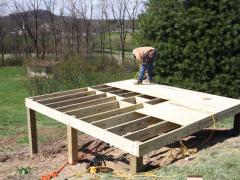 Pier foundation under the shed is usually digged into the soil to a depth of its freezing. Unfortunately, this type of a foundation can not be used on moving grounds. First you need to dig holes in the ground where there will be posts. The depth of the holes should be the extra 0,5 feet deep than usual freezing of the soil. The bottom of the pit is filled with a mixture of sand and gravel. After everything is done it will be possible to mount the posts which may be made of concrete blocks, concrete mortar filled asbestos pipes or represent a conventional brickwork. Inside each post an iron rod should be installed for increasing the carrying capacity of the pillars. If you use brickwork it is very important to treat it with waterproof mastic. Isolation of moisture is also necessary for wooden bases of sheds. For doing this just cover your foundation with some moisture barrier material and then place the top of the base.
Pier foundation under the shed is usually digged into the soil to a depth of its freezing. Unfortunately, this type of a foundation can not be used on moving grounds. First you need to dig holes in the ground where there will be posts. The depth of the holes should be the extra 0,5 feet deep than usual freezing of the soil. The bottom of the pit is filled with a mixture of sand and gravel. After everything is done it will be possible to mount the posts which may be made of concrete blocks, concrete mortar filled asbestos pipes or represent a conventional brickwork. Inside each post an iron rod should be installed for increasing the carrying capacity of the pillars. If you use brickwork it is very important to treat it with waterproof mastic. Isolation of moisture is also necessary for wooden bases of sheds. For doing this just cover your foundation with some moisture barrier material and then place the top of the base.
A foam blocks foundation
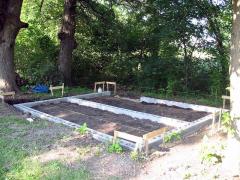 This type is quite common as its use increases the life of the whole construction. Foam is a versatile material, it can be used to make the base for any building. Low costs are also contribute much to the popularity of this material in construction processes. Besides, concrete blocks are lighter than other materials, so the base does not have a strong loads on it. Start by marking your site. Schedule and dug pegs, pull a cord between them. Now you can dig a pit the depth of which should be about 2 feet. The width is the width of the foam blocks themselves plus extra 0,5 foot. A mixture of gravel and sand should be put at the bottom of the pit, then set a frame and pour concrete. The height of your foundation should be about 8 inches. Now you need to wait until the concrete is completely dry, then set your blocks.
This type is quite common as its use increases the life of the whole construction. Foam is a versatile material, it can be used to make the base for any building. Low costs are also contribute much to the popularity of this material in construction processes. Besides, concrete blocks are lighter than other materials, so the base does not have a strong loads on it. Start by marking your site. Schedule and dug pegs, pull a cord between them. Now you can dig a pit the depth of which should be about 2 feet. The width is the width of the foam blocks themselves plus extra 0,5 foot. A mixture of gravel and sand should be put at the bottom of the pit, then set a frame and pour concrete. The height of your foundation should be about 8 inches. Now you need to wait until the concrete is completely dry, then set your blocks.
Block foundation
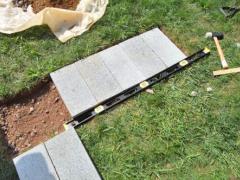 Block foundations have a number of advantages, such as resistance to low temperatures and acids of soil,
Block foundations have a number of advantages, such as resistance to low temperatures and acids of soil,
excellent mechanical properties and long life. The construction of it should begin from corners where you put the first set of blocks. Blocks are put on concrete solution. If the ground is loose the reliability of future construction is necessary to improve with installing a metal grid. Control laying of a foundations with a level – it helps to avoid the occurrence of curvature. Then the outer joints are expanded and filled with a composition with additives containing moisture protection. Hydroisolation is also needed around the outer contour of the ground. Then dig a trench.

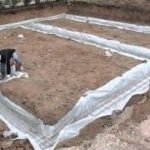
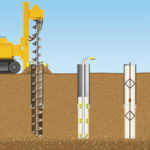
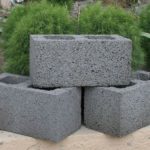
How to build a shed foundation with your own hands
Foundations categorized as on-grade sit directly on the ground and are the quicker of the two foundation types to construct. This is because they often are made of lumber or concrete blocks that do not require digging deep holes or pouring concrete footings. On-grade foundations tend to be cheaper to build, but can be used only with small- to medium-sized sheds.
You can build a geocell shed base without fabric material, but our team suggests it. There’s a chance your infill gravel will seep through the soil and leave space in the geocells, creating unstable ground.